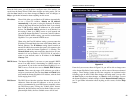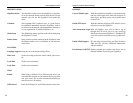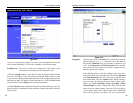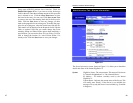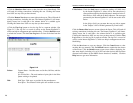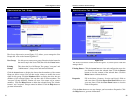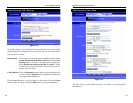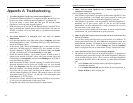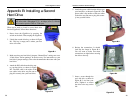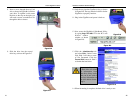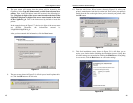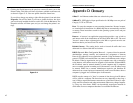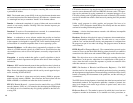
3. When I click the Instant GigaDrive’s icon in Network Neighborhood, I’m
prompted for a password.
This can happen in the following situations:
• Your Windows Logon name is recognized by the Instant GigaDrive™, but
your Logon password is not. Simply enter your password, or make your
Windows password the same as the Instant GigaDrive’s password.
• Your Windows Logon name is not recognized by the Instant GigaDrive™,
defaulting you to guest access rights. If you are not the Network
Administrator, ask your Administrator to create a user name for you. (Use
the same name as your Logon name.)
• You do not have access permission for this share. If you are not the Network
Administrator, ask your Administrator to grant you access.
4. When using the web interface, some of the data will not fit on the screen, and
there is no scroll bar.
• You are likely using extra-large fonts in your browser or in Windows. To
change your browser’s font size, select View from your browser’s menu, and
change the font size there. To change the size of your Windows fonts, go to
Display in the Control Panel. Choose Settings, then click the Advanced
button. Change the font size to either Small or Large. Both should work.
5. A print job does not print and no error message is displayed.
• The amount of free disk space on the Instant GigaDrive™ is probably not
sufficient to spool (queue) the print job. The Instant GigaDrive’s disk usage
can be checked using the Status - Disk screen on the Instant GigaDrive’s
Administrator interface. If this is the problem, you must delete some print
jobs.
1. Select Printer from the Status menu of the Instant GigaDrive’s
Administrator interface.
2. Use the Delete Current Job option to delete the current print job, or
Delete All Jobs to delete all print jobs.
Appendix A: Troubleshooting
1. The Instant GigaDrive™ Utility can’t find the Instant GigaDrive™.
• Check that the Instant GigaDrive™ is properly installed, that the LAN con-
nections are secure, and that the Instant GigaDrive™ is powered ON.
• If you are using a router, make sure that your PC and the Instant
GigaDrive™ are on the same network segment.
• Make sure that your PC has the TCP/IP network protocol installed. This is
done by checking the Network option of the Control Panel. If an entry for
TCP/IP -> Network card is not listed, refer to your Microsoft documenta-
tion to add it.
2. The Instant GigaDrive™ is configured, but I can’t find it in Network
Neighborhood.
• Go to the Find function in the Start menu. Choose Computer, then enter
the Instant GigaDrive’s name. In Windows 2000, go to Files and Folders to
search the Computer option.
• If this doesn’t work, choose the Network option of the Control Panel to
check that a TCP/IP protocol is installed. If it isn’t installed, use Add -
Protocol - Microsoft - TCP/IP to install it. In Windows 2000, click Install,
not Add. In Windows NT, click the Protocols tab, then Add.
• Check the network bindings. First, ensure that the TCP/IP protocol is
bound to your network card (NIC). Then, select your network card in the
Control Panel, click Properties, and choose the Bindings tab. If TCP/IP is
not bound (checked), check it.
• Make sure that the TCP/IP -> network card entry is bound to the Client for
Microsoft Networks service. Select the TCP/IP entry for your network
Card, click Properties, and then choose the Bindings tab. If Client for
Microsoft Networks is not bound (checked), check it.
• If you don’t have a router, make sure that your IP Address is compatible
with the Instant GigaDrive’s IP Address. This means it needs to be in the
same address range (e.g. 192.168.1.3 to 192.168.1.254) and using the same
Subnet Mask (e.g. 255.255.255.0)
• If you do have a router, check that your Gateway IP Address is set correct-
ly. Ask your LAN administrator for the correct value.
• Change the name back to the Instant Gigadrive’s default name.
38
EtherFast
®
Network Attached StorageInstant GigaDrive
TM
Series
37



